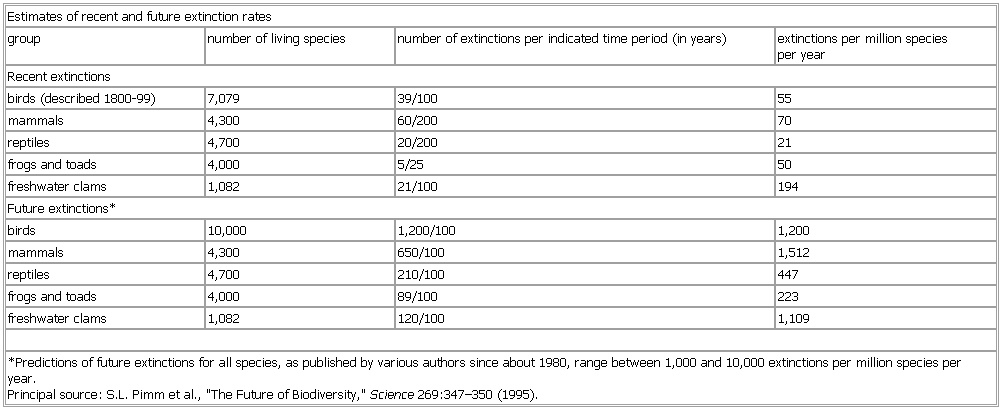Estimates of recent and future extinction rates
- Estimates of recent and future extinction rates
-
Estimates of recent and future extinction rates
group number of living species number of extinctions per indicated time period (in years) extinctions per million species
per year
Recent extinctions
birds (described 1800-99) 7,079 39/100 55
mammals 4,300 60/200 70
reptiles 4,700 20/200 21
frogs and toads 4,000 5/25 50
freshwater clams 1,082 21/100 194
Future extinctions*
birds 10,000 1,200/100 1,200
mammals 4,300 650/100 1,512
reptiles 4,700 210/100 447
frogs and toads 4,000 89/100 223
freshwater clams 1,082 120/100 1,109
*Predictions of future extinctions for all species, as published by various authors since about 1980, range between 1,000 and 10,000 extinctions per million species per year.
Principal source: S.
L.
Pimm et al., "
The Future of Biodiversity,"
Science 269:347–
350 (
1995).
See as table:
* * *
Universalium.
2010.
Look at other dictionaries:
List of countries by past and future population — This article shows the (absolute) population of nearly all the political countries and dependencies in the world from 1950 to 2050. This one century timespan provides a broad perspective on demographic change across the globe. According to these… … Wikipedia
Extinction event — … Wikipedia
conservation — conservational, adj. /kon seuhr vay sheuhn/, n. 1. the act of conserving; prevention of injury, decay, waste, or loss; preservation: conservation of wildlife; conservation of human rights. 2. official supervision of rivers, forests, and other… … Universalium
Holocene extinction event — [ thumb|right|150px|The Dodo, a bird of Mauritius, became extinct during the mid late seventeenth century after humans destroyed the forests where the birds made their homes and introduced animals that ate their eggs.] The Holocene extinction… … Wikipedia
Human extinction — is the end of the human species. Various scenarios have been discussed in science, popular culture, and religion (see End time). The scope of this article is existential risks. Humans are very widespread on the Earth, and live in communities… … Wikipedia
Holocene extinction — The dodo, a bird of Mauritius, became extinct during the mid late seventeenth century after humans destroyed the forests where the birds made their homes and introduced mammals that ate their eggs. The Holocene extinction refers to the extinction … Wikipedia
Media and Publishing — ▪ 2007 Introduction The Frankfurt Book Fair enjoyed a record number of exhibitors, and the distribution of free newspapers surged. TV broadcasters experimented with ways of engaging their audience via the Internet; mobile TV grew; magazine… … Universalium
Climate change, industry and society — See also: Avoiding dangerous climate change and Effects of climate change on humans This article is about climate change, industry and society. Contents 1 Vulnerability 1.1 General effects 1.2 Human settlement … Wikipedia
HISTORICAL SURVEY: THE STATE AND ITS ANTECEDENTS (1880–2006) — Introduction It took the new Jewish nation about 70 years to emerge as the State of Israel. The immediate stimulus that initiated the modern return to Zion was the disappointment, in the last quarter of the 19th century, of the expectation that… … Encyclopedia of Judaism
Climate Change: Global Risks, Challenges and Decisions — See also: Avoiding dangerous climate change and 4 Degrees and Beyond International Climate Conference Climate Change: Global Risks, Challenges and Decisions was a conference on Climate Change held at the Bella Center by the University of… … Wikipedia

